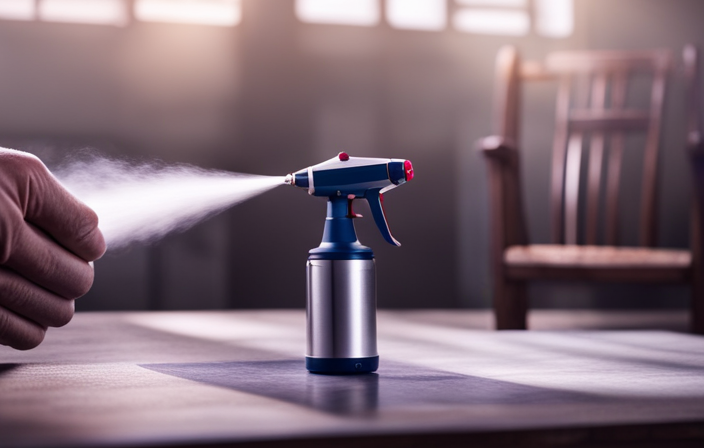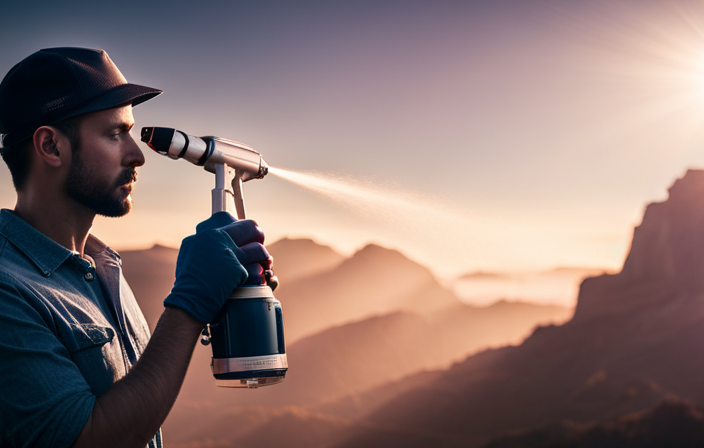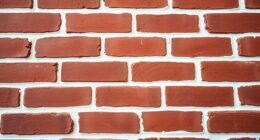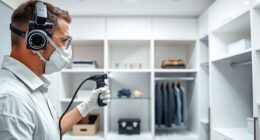Have you ever wanted to achieve smooth, professional-grade strokes with an airless paint sprayer? I am here to show you how it’s done.
Picture this: you’re painting the interior of your home and you want to add some decorative lines to really make the room pop. With an airless paint sprayer, you can achieve those crisp, straight lines with ease.
In this article, I will guide you through the step-by-step process of using an airless paint sprayer to create perfect lines. From setting up and choosing the right nozzle, to practicing your technique and maintaining consistency, I’ll cover it all.
By the end, you’ll have the confidence and knowledge to tackle any line painting project. So grab your airless paint sprayer and let’s get started!
Key Takeaways
- Benefits of using an airless paint sprayer include adding decorative lines to the interior of your home.
- Proper preparation of the sprayer is essential for achieving flawless lines, including cleaning it thoroughly and checking paint viscosity.
- Nozzle selection and preparation are important, with the right nozzle size indicated by a three-digit number.
- Surface preparation is crucial, including cleaning, priming, filling cracks and holes, and applying primer for better adhesion and a uniform base.
Set up and prepare your airless paint sprayer
Get ready to unleash the power of your airless paint sprayer by setting it up and getting it prepped for flawless lines.
Before you begin, make sure to clean the sprayer thoroughly to remove any residue or debris that could affect the quality of your lines.
Next, check the paint viscosity and adjust it if necessary by thinning the paint. This’ll ensure smooth and even brush strokes.
Once the sprayer is set up and the paint is properly thinned, it’s time to choose the right nozzle for creating lines. The nozzle size’ll depend on the width and thickness of the lines you want to achieve. So, select the appropriate nozzle and attach it securely to the sprayer.
Now you’re ready to move on to the next step and start creating those perfect lines.
Choose the right nozzle for creating lines
To achieve precise and well-defined strokes, it’s essential to select the appropriate nozzle for your desired line thickness, just like choosing the right brush size for a masterpiece.
Nozzle selection plays a crucial role in line thickness control when using an airless paint sprayer. Different nozzles produce different spray patterns, allowing you to create lines of varied widths.
The nozzle size is indicated by a three-digit number, where the first two digits represent the fan width in inches, and the last digit represents the orifice size in thousandths of an inch. For example, a 515 nozzle would have a 5-inch fan width and a 0.015-inch orifice size.
By choosing the right nozzle, you can ensure that your lines are precise and uniform.
Now, before painting, let’s move on to the next section and learn how to clean and prime the surface effectively.
Clean and prime the surface before painting
Before you start painting, it’s crucial to properly clean and prime the surface for optimal results. Surface preparation is key to achieving a smooth and professional finish. First, ensure that the surface is free from dust, dirt, and grease by wiping it down with a damp cloth. Next, fill any cracks or holes with a suitable filler and sand it smooth. Once the surface is clean and smooth, apply a primer to promote better adhesion and prevent peeling or flaking. A primer also helps to even out the surface and create a uniform base for paint application. Proper paint application ensures that the lines created with the airless paint sprayer are crisp and well-defined. Remember, practice your technique on a scrap piece of material to perfect your skills before tackling the actual painting project.
Practice your technique on a scrap piece of material
Practicing your technique on a scrap piece of material is an imperative step in honing your skills and ensuring a flawless outcome when painting. Perfecting your brush stroke technique is crucial to achieving clean and precise lines with an airless paint sprayer.
By practicing on a scrap piece of material, you can experiment with different paint thicknesses and determine the right consistency for your desired result. This will allow you to adjust the paint flow and pressure accordingly.
Additionally, practicing will help you get familiar with the sprayer’s controls and optimize your hand movement for smooth and consistent strokes. Once you have perfected your technique, you can confidently start painting your lines from top to bottom or left to right, creating a professional finish.
Start painting your lines from top to bottom or left to right
Begin by smoothly gliding your brush along the surface, starting from the top and working your way down, or from left to right, creating a seamless flow of color. When using an airless paint sprayer, mastering the proper painting techniques is crucial to achieving clean and professional-looking lines. Many painters make the common mistake of rushing through the process, resulting in uneven and messy lines. To avoid this, it is important to maintain a steady and even pressure on the sprayer throughout the entire stroke. By doing so, you will ensure a consistent coverage and prevent any streaks or drips. Remember to keep your movements smooth and controlled, and always overlap each stroke slightly to create a seamless finish. Transitioning into the next section, it is equally important to use steady and even pressure on the sprayer to achieve optimal results.
Use steady and even pressure on the sprayer
Ensure that you maintain a constant and smooth pressure on the sprayer, creating flawless and professional-looking results. By applying steady pressure, you’ll achieve even coverage of paint on the surface you’re working on. This is crucial to avoid streaks or uneven lines.
It’s important to keep the pressure consistent throughout the entire painting process, ensuring a uniform finish. By doing so, you’ll achieve a clean and seamless result, free from any imperfections.
As you maintain a steady and even pressure on the sprayer, it’s equally important to maintain a consistent distance from the surface. This will be discussed in detail in the next section, ensuring you achieve optimal results.
Maintain a consistent distance from the surface
As I glide the sprayer across the surface, like a graceful dancer maintaining perfect form, I ensure to maintain a consistent distance to achieve flawless and even coverage. This is a crucial step in achieving professional-looking lines with an airless paint sprayer.
By maintaining a consistent distance from the surface, I can ensure that the paint is applied evenly and without any streaks or gaps. Proper technique is key here, as too close of a distance can result in an uneven application, while too far can lead to overspray. By practicing and mastering this skill, I can achieve a smooth and consistent finish every time.
Now, let’s move on to the next step and discuss the importance of overlapping each line slightly for a seamless finish.
Overlap each line slightly for a seamless finish
Maintaining a consistent distance from the surface ensures an even application of paint, but there’s another crucial element to achieving a professional finish: overlapping each line slightly. This technique creates a seamless finish by blending the edges together, eliminating any visible lines or streaks.
To achieve this, start each new line slightly over the previous one, making sure to keep a steady pace and maintain a consistent distance. The key is to use a smooth, fluid motion to create a continuous spray pattern. By overlapping each line, you create a uniform coat of paint that hides any imperfections and gives your project a flawless look.
To enhance your painting experience, consider these five tips:
- Use high-quality paint to achieve a vibrant color.
- Practice proper safety measures, including wearing protective gear.
- Prepare the surface thoroughly to ensure proper adhesion.
- Take breaks to avoid fatigue and maintain focus.
- Clean the equipment promptly to prolong its lifespan and maintain optimal performance.
When it’s time to move on to the next step, remember to take breaks to allow the paint to dry between coats.
Take breaks to allow the paint to dry between coats
Remember to give yourself a break and let the paint dry between coats, so you can come back to a flawless finish that’ll make your project shine. Applying multiple coats of paint is crucial for achieving a smooth and even finish with an airless paint sprayer. Each coat helps to build up the color and coverage, ensuring that the final result is uniform and professional-looking.
To speed up the drying process between coats, there are a few tips you can follow. First, make sure to apply thin coats of paint, as thicker coats take longer to dry. Additionally, you can increase ventilation in the area by opening windows or using fans. If you’re in a hurry, using a dehumidifier or a heat gun can also help to speed up the drying time.
By allowing proper drying time between coats, you’ll be able to achieve a flawless and long-lasting finish for your project.
Once you’ve completed your painting job, it’s important to clean and store your airless paint sprayer properly to keep it in good condition.
[Transition sentence]: Now let’s move on to the next step of cleaning and storing your airless paint sprayer after use.Clean and store your airless paint sprayer properly after use
To ensure the longevity of your equipment, it’s crucial that you properly clean and store your airless paint sprayer after each use. Failure to do so can result in clogged nozzles and decreased efficiency. Did you know that approximately 90% of paint sprayer issues are caused by improper cleaning and storage?
Proper storage and maintenance of your airless paint sprayer is essential for optimal performance. After each use, start by flushing out any remaining paint by running clean water through the sprayer until it runs clear. Remove the nozzle and filter and clean them thoroughly with a brush and water. Wipe down the entire sprayer with a damp cloth to remove any paint residue.
Finally, store your airless paint sprayer in a clean and dry place, away from extreme temperatures and moisture. Following these steps will help prolong the life of your equipment and ensure it functions at its best for future use.
Frequently Asked Questions
How do I choose the right paint for creating lines with an airless paint sprayer?
To choose the right paint for creating lines with an airless paint sprayer, consider using acrylic or latex paints that are specifically formulated for line striping. These paints provide good adhesion, durability, and visibility on various surfaces.
What safety precautions should I take when using an airless paint sprayer?
To ensure safety when using an airless paint sprayer, it’s crucial to take proper precautions. This includes wearing protective gear, such as goggles and gloves, and ensuring proper ventilation in the workspace.
How do I troubleshoot common issues with an airless paint sprayer while creating lines?
To troubleshoot common issues with an airless paint sprayer while creating lines, use these troubleshooting techniques. Ensure the paint type is compatible with the sprayer and check for clogs, pressure problems, or worn parts.
Can I use an airless paint sprayer to create lines on different surfaces, such as wood or metal?
Yes, an airless paint sprayer can be used to create straight lines on various surfaces like wood or metal. To achieve the desired line thickness, it is important to follow best practices such as adjusting the spray tip size and maintaining a consistent distance while spraying.
Are there any specific techniques or tips for creating curved or intricate lines with an airless paint sprayer?
For creating curved lines with an airless paint sprayer, it’s important to adjust the spray pattern and pressure to achieve the desired shape. Additionally, using a smaller spray tip and practicing steady hand movements can help create intricate lines.
Conclusion
So there you have it, a simple and effective guide on how to do lines with an airless paint sprayer. By following these steps and practicing your technique, you can achieve professional-looking lines with ease.
Remember to choose the right nozzle, clean and prime the surface, and maintain a consistent distance from the surface. Don’t forget to take breaks between coats and clean and store your airless paint sprayer properly after use.
So grab your sprayer and get painting those perfect lines!










